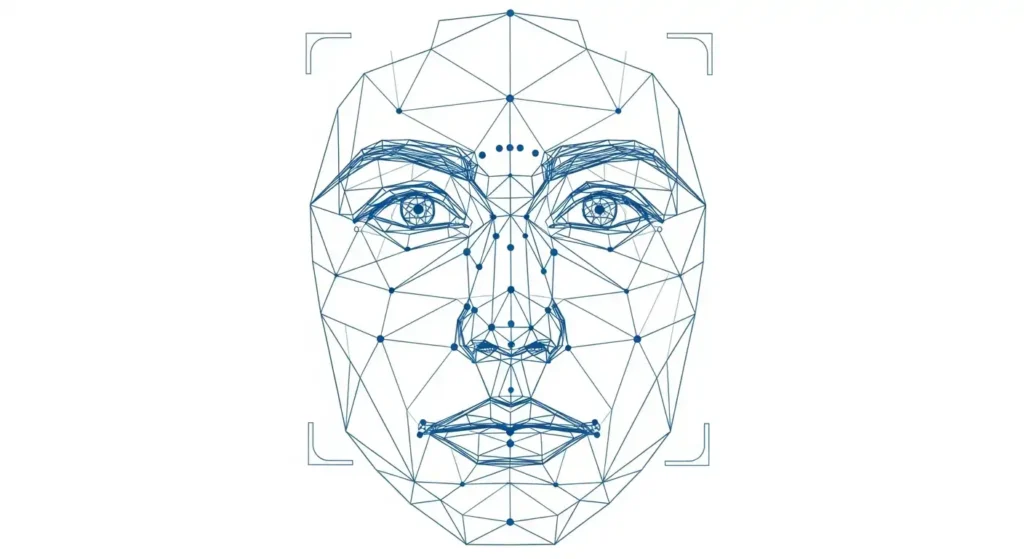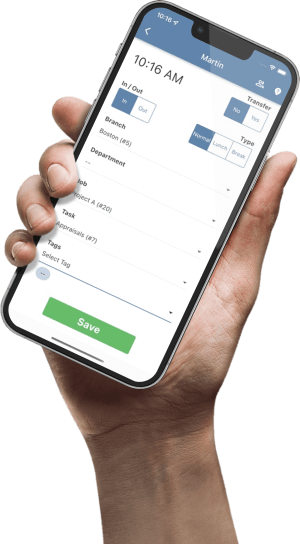
Eliminate Buddy Punching With Biometric Facial Recognition
For small business owners, payroll accuracy is paramount. A significant threat to this accuracy is buddy punching, a form of time theft that costs U.S. employers millions annually. This article explores how biometric facial recognition technology offers a definitive solution to buddy punching and time theft. We'll delve into how workforce management systems like TimeTrex leverage facial recognition to ensure data integrity, improve efficiency, and protect your bottom line. Understanding this technology, its benefits, legal implications, and how to implement it strategically is crucial for modern business management.
TL;DR
Buddy punching (an employee clocking in for another) is a costly form of time theft. Traditional methods like PINs or cards can't stop it. Biometric facial recognition provides a foolproof solution by verifying an employee's physical presence, making time theft impossible. This technology converts facial features into a secure digital template (not a photo) for matching. Integrating it with a workforce management system like TimeTrex automates payroll, reduces errors, and boosts efficiency. However, implementation requires navigating a complex legal landscape, especially state privacy laws like Illinois' BIPA. Success depends on a transparent, compliance-first approach and careful vendor selection.
Article Contents
- The Pervasive Challenge of Time Theft and Workplace Inefficiency
- The Technological Countermeasure: Biometric Facial Recognition Explained
- Vendor Deep Dive: TimeTrex and its Facial Recognition Platform
- The Risk Matrix: Navigating Legal, Ethical, and Technical Minefields
- Strategic Implementation and Recommendations
The Pervasive Challenge of Time Theft and Workplace Inefficiency
The integrity of time and attendance data forms the bedrock of payroll accuracy, operational efficiency, and workplace fairness. Yet, for many organizations, this foundation is systematically undermined by a practice known as "buddy punching." This form of time theft, while often perceived as a minor transgression, represents a significant and multifaceted threat to a business's financial health, cultural integrity, and legal standing. Understanding the deep-rooted causes and quantifying the extensive damage of this practice is the first step toward evaluating modern technological countermeasures.
Deconstructing "Buddy Punching": A Systemic and Cultural Failure
At its most basic level, buddy punching is a fraudulent act wherein one employee clocks in or out for a colleague who is absent, arriving late, or leaving early. This manipulation of time records is most common in environments that rely on easily transferable credentials or manual systems, such as paper timesheets, shared PINs, or swipeable ID cards, which lack a mechanism to verify the identity of the person performing the action. Scenarios range from a coworker punching in for a friend stuck in traffic to more deliberate schemes involving covering entire missed shifts.
However, viewing buddy punching solely as an act of individual dishonesty is a critical oversimplification. The practice is often a symptom of deeper, systemic failures within an organization's policies and culture. Several key drivers contribute to its prevalence:
- Strict and Inflexible Policies: Organizations with rigid attendance policies inadvertently create a powerful incentive for employees to cheat. When minor infractions can lead to disciplinary action, employees may feel compelled to ask a colleague for a "favor" to protect their job.
- Low Morale and Disengagement: A disengaged workforce is a significant risk factor. Employees who feel undervalued may rationalize time theft as a form of protest or a way to "get back" at an employer they perceive as unfair.
- Peer Pressure and Lack of Awareness: In some workplace cultures, buddy punching is normalized. This is especially true when employees are not explicitly educated on the fact that it constitutes fraud and has serious financial and operational consequences.
- Absence of Consequences: Perhaps the most significant enabler is the lack of effective preventative measures. When employees observe that buddy punching is easy to accomplish and carries little risk, it creates a permissive environment where the behavior can spread.
This analysis reveals that buddy punching is not merely an employee problem but an organizational one. Its persistence can signal that existing policies are misaligned with the practical realities of the workforce.
Quantifying the Financial Hemorrhage: The Direct and Indirect Costs
The financial impact of buddy punching is substantial. According to industry research, buddy punching costs U.S. employers an estimated $373 million annually. For businesses in high-risk sectors, time theft can account for as much as 2.2% of gross annual payroll. Data from the American Payroll Association indicates that a remarkable 75% of U.S. businesses are affected by time theft, with buddy punching being a primary contributor.
To contextualize these percentages, consider the modeled financial impact on businesses of varying sizes. As shown in the table below, even a seemingly small percentage loss translates into significant annual costs. One study from a mid-sized construction firm with 150 employees estimated its annual losses from buddy punching at $125,000 before implementing biometric controls.
| Company Size (Employees) | Total Annual Work Hours | Total Annual Payroll (at $20/hr) | Estimated Annual Loss from Buddy Punching (2.2% of Gross Payroll) |
|---|---|---|---|
| 50 | 104,000 | $2,080,000 | $45,760 |
| 250 | 520,000 | $10,400,000 | $228,800 |
| 1,000 | 2,080,000 | $41,600,000 | $915,200 |
| 5,000 | 10,400,000 | $208,000,000 | $4,576,000 |
The financial damage is not limited to direct payroll losses. Significant indirect costs amplify the problem, including lost productivity, skewed performance metrics, and a heavy administrative burden on HR and payroll staff who must manually correct inaccurate timesheets.
Beyond the Balance Sheet: The Erosion of Culture and Trust
While the financial costs are alarming, the intangible damage to an organization's culture can be even more destructive. When diligent staff members observe colleagues engaging in time theft without consequence, it fosters resentment and demotivates high-performers. This perception of unfairness can lead to widespread disengagement, creating a culture where dishonesty is tolerated. This cultural decay has direct operational consequences, as absent employees force coworkers to pick up the slack, leading to increased stress and burnout. Finally, the practice introduces significant legal and compliance risks, as employers are legally obligated to pay for all hours logged, even if they suspect fraud.
The Technological Countermeasure: Biometric Facial Recognition Explained
In response to the significant costs of time theft, organizations are turning to biometric technologies. Among these, facial recognition has emerged as a powerful countermeasure due to its accuracy, efficiency, and hygienic, contactless nature. By fundamentally changing how an employee's presence is verified, this technology aims to make fraudulent practices like buddy punching impossible.
From Face to Data: The Biometric Authentication Process
It is a common misconception that facial recognition systems store photographs. The actual process is far more sophisticated and privacy-conscious, centered on creating a unique digital signature from an individual's facial geometry. The process involves three phases:
- Detection and Capture: A high-resolution camera scans the environment to detect a face.
- Analysis and Feature Extraction: The software identifies and measures dozens of unique landmarks on the face, such as the distance between the eyes and the width of the nose.
- Template Creation and Matching: These measurements are converted by an algorithm into a secure, encrypted mathematical template—a "faceprint." This numerical representation is what is stored, not a photograph. During a subsequent clock-in, the system creates a new template and compares it to the stored one for verification.
Crucially, workforce management systems use 1:1 authentication (verifying "Is this person Jane Doe?") rather than the more controversial 1:N identification (asking "Who is this person?" against a large database) associated with public surveillance. This distinction is vital for legal and ethical positioning, as it demonstrates the technology's use is proportionate and minimally intrusive.
Core Operational Benefits: Accuracy, Efficiency, and Safety
The implementation of biometric facial recognition delivers a suite of tangible operational benefits:
- Elimination of Time Theft: By linking attendance to unique biological characteristics, it renders buddy punching impossible, ensuring absolute data integrity.
- Unparalleled Accuracy and Reduced Errors: Automation removes human error from manual data entry, leading to highly accurate time data and reducing costly payroll corrections.
- Enhanced Speed and Operational Efficiency: The clock-in process takes as little as a second, preventing bottlenecks at the start of shifts and allowing work to begin promptly.
- Contactless and Hygienic Operation: The touch-free nature minimizes the transmission of germs, contributing to a safer workplace—an ideal solution for industries with stringent health protocols.
Integration and the HR Ecosystem
The strategic value of facial recognition is magnified when integrated into a broader ecosystem of HR and business management software. Key integrations include payroll systems (like ADP or QuickBooks), Human Resources Information Systems (HRIS), and access control systems. This creates a seamless flow of data, automating the entire "time-to-pay" process and generating significant "soft" savings by reclaiming administrative hours in HR and payroll departments.
Vendor Deep Dive: TimeTrex and its Facial Recognition Platform
Moving from general capabilities to a specific market offering, this section analyzes TimeTrex, a prominent vendor in the workforce management space. By scrutinizing its technology, security, and market perception, we can build a comprehensive picture of its platform.
The TimeTrex Technology Stack and Process
TimeTrex positions its facial recognition technology as a versatile solution designed primarily to "eliminate buddy punching." A core element of its strategy is transforming standard mobile devices, like tablets or smartphones, into fully functional biometric time clocks. This approach significantly lowers the barrier to entry for businesses by reducing the need for expensive, specialized hardware.
The employee-facing experience is marketed as a simple "Look & Go" process, with punches completed in as little as one second. The underlying system is built on sophisticated algorithms that can correctly identify employees even with hats, glasses, or facial hair. A critical feature for industries like construction or field services is its offline capability; the app stores punch data locally during network interruptions and syncs automatically once connectivity is restored.
| Feature | TimeTrex Specification |
|---|---|
| Technology | Sophisticated facial recognition algorithms analyzing facial landmarks; recognizes hats, glasses, facial hair. |
| Data Storage | Facial data is converted into secure, encrypted digital codes (templates); raw images are not stored. |
| Hardware | Utilizes existing mobile devices (tablets, phones) as biometric kiosks; no specialized hardware required. |
| Offline Mode | Yes. Stores punches locally and syncs when internet connection is restored. |
| Key Integrations | Full workforce management platform (Payroll, HR, Scheduling); GPS & Geofencing; API for third-party systems (ADP, QuickBooks). |
| Compliance Claims | States solution is "fully compliant with GDPR and other privacy regulations." |
| Key User Criticisms | Administrator interface can be cluttered, confusing, and inconsistent; mobile app perceived as outdated. |
Data Security and Privacy Architecture: A Critical Analysis
At the heart of TimeTrex's security is a critical architectural choice: the system transforms captured facial data into "secure algorithms, stored as encrypted digital codes, and not as photographic images." This is a fundamental privacy-enhancing technique. While TimeTrex asserts its solution is "fully compliant with GDPR and other privacy regulations," it is imperative for a potential buyer to be cautious. Under laws like the Illinois Biometric Information Privacy Act (BIPA), the encrypted template is still legally defined as "biometric information." The ultimate legal liability rests with the employer, who must ensure proper notice, consent, and data policies are in place.
The Complete Workforce Management Solution
TimeTrex strategically positions its facial recognition not as a standalone product, but as an integrated feature within a comprehensive, all-in-one workforce management platform. This includes modules for Time & Attendance, Payroll & Tax Management, Employee Scheduling, and Human Resources. This all-in-one strategy provides a seamless, single-vendor experience, though a business should evaluate the entire platform to ensure all components meet its broader needs.
Market Perception and User Experience: A Reality Check
While customer testimonials praise TimeTrex for its effectiveness in tracking time, independent user reviews provide a more nuanced perspective. A recurring theme in feedback is the complexity of the administrative user interface, with multiple reviews describing the dashboard as "cluttered," "confusing," and "dated." This suggests a dichotomy: the employee-facing function is simple, but the backend administrative experience may require a significant learning curve.
The Risk Matrix: Navigating Legal, Ethical, and Technical Minefields
While the benefits are compelling, they are counterbalanced by a complex matrix of risks. A thorough understanding of technological fallibility, the legal landscape, and potential erosion of employee trust is essential for any business considering this technology.
Algorithmic Integrity: The Challenge of Bias and Accuracy
A primary concern with facial recognition is demographic bias. Authoritative research from the U.S. National Institute of Standards and Technology (NIST) has confirmed that many algorithms exhibit higher error rates for women, people of color, and the elderly, often due to unbalanced training data. However, the same research shows that the most accurate, top-tier algorithms have "undetectable" differences in performance. The implication for employers is clear: rigorous due diligence is paramount. You must demand independent, third-party audit results for the specific algorithm being procured, with performance data broken down by demographic subgroups to avoid potential discrimination claims.
The Regulatory Gauntlet: BIPA and the Specter of Litigation
The most significant risk for U.S. employers is legal liability, especially in Illinois. The state's Biometric Information Privacy Act (BIPA) imposes strict obligations on any entity collecting biometric data:
- Provide written notice of collection and purpose.
- Receive an explicit, written release (consent) from the employee.
- Publish a public-facing data retention and destruction schedule.
Non-compliance can lead to substantial financial penalties. Although a 2024 amendment to BIPA reduced the risk of "annihilative" damages by changing liability from "per scan" to "per person," the threat of costly litigation remains. Lawsuits have targeted both employers and technology vendors, forcing a collaborative approach to compliance.
A Patchwork of Laws: The Broader U.S. Regulatory Landscape
Beyond Illinois, employers must navigate a complex patchwork of state privacy laws, as no single federal standard exists. States like Texas, California, and Virginia have their own rules governing biometric data collection and use.
| State | Law | Key Requirement(s) | Private Right of Action | Statutory Penalties |
|---|---|---|---|---|
| Illinois | BIPA | Written notice, written consent, public retention policy. | Yes | $1,000-$5,000 per violation. |
| Texas | CUBI | Consent required before capture; data must be destroyed within 1 year after purpose ends. | No | Up to $25,000 per violation. |
| California | CCPA/CPRA | Notice of collection; grants employees rights to access, delete, and correct their data. | Yes (for data breaches) | $2,500-$7,500 per violation. |
| Virginia | VCDPA | Explicit "opt-in" consent required before processing sensitive data. | No | Up to $7,500 per violation. |
Due to these variations, the best practice is to craft policies that meet the standards of the most stringent applicable law—often BIPA—and apply that standard across all operations.
Employee Trust and Ethical Boundaries
Beyond legal risks lies the challenge of overcoming employee skepticism. The deployment of facial recognition can be perceived as invasive surveillance. A 2023 Pew Research study found widespread public concern about the technology's potential for bias and misinterpretation. To navigate this, a successful implementation must be treated as a change management project. Employers must be radically transparent, clearly communicating what data is collected, why it's collected, and how it's secured. Providing a non-biometric alternative is key to an ethical implementation that can earn employee buy-in.
Strategic Implementation and Recommendations
The decision to adopt biometric facial recognition demands a holistic approach that balances operational efficiency with a rigorous commitment to legal compliance, ethics, and governance.
A Compliance-First Implementation Framework
Before deploying any technology, a comprehensive compliance framework must be established. This involves conducting a Data Protection Impact Assessment (DPIA), documenting a legitimate purpose for data collection, drafting BIPA-standard policies, and implementing a robust, standalone consent process. Proactive, transparent communication with employees is critical to demystify the technology and explain the benefits from their perspective.
Vendor Due Diligence Checklist: Beyond the Marketing Slicks
Selecting a vendor is a critical step. Due diligence must extend beyond features and pricing to a deep examination of the vendor's technology, security, and willingness to act as a compliance partner. A competitive landscape analysis is a good starting point.
| Vendor | Core Offering | Facial Recognition Method | Key Differentiator | Pricing Model |
|---|---|---|---|---|
| TimeTrex | All-in-one WFM Platform | AI-powered biometric verification | Comprehensive suite (Payroll, HR, Scheduling); Offline mode | Tiered subscription per employee |
| Timeero | Time & GPS Tracking Focus | AI face detection system | Strong mobile/field team focus; Kiosk app is iOS-only | Per-user monthly subscription |
| Jibble | Time Tracking Focus | AI-powered selfie verification | Robust "Free Forever" plan with facial recognition included | Freemium model with paid tiers |
| QuickBooks Time | Time Tracking for QB Ecosystem | Optional facial recognition | Deep integration with QuickBooks ecosystem | Per-user monthly subscription |
A prospective buyer should demand independent algorithmic performance audits, technical verification of security architecture, and contractual terms that establish shared liability and vendor indemnification.
Final Verdict and Strategic Outlook
Biometric facial recognition technology offers a powerful solution to time theft. The ROI from eliminating fraudulent hours and reducing administrative overhead can be substantial. However, this is balanced by severe legal, technical, and ethical risks.
Adoption is only suitable for organizations with a high degree of operational maturity and an unwavering commitment to legal compliance, ethical implementation, and rigorous vendor governance. Ultimately, implementing this technology forces a re-evaluation of workplace policies. A successful deployment is one that not only installs new software but also uses the opportunity to modernize HR policies, creating a more flexible and trusting environment where the need for employees to cheat is minimized in the first place. For vendors like TimeTrex, long-term success will be defined not just by their algorithms, but by their ability to serve as trusted compliance and risk-management partners in this complex domain.
Ready to Eliminate Buddy Punching for Good?
Discover how TimeTrex's Biometric Facial Recognition can secure your payroll, increase efficiency, and bring a new level of accuracy to your workforce management. See our solution in action and find the right plan for your business.
Learn More About TimeTrex Facial RecognitionDisclaimer: The content provided on this webpage is for informational purposes only and is not intended to be a substitute for professional advice. While we strive to ensure the accuracy and timeliness of the information presented here, the details may change over time or vary in different jurisdictions. Therefore, we do not guarantee the completeness, reliability, or absolute accuracy of this information. The information on this page should not be used as a basis for making legal, financial, or any other key decisions. We strongly advise consulting with a qualified professional or expert in the relevant field for specific advice, guidance, or services. By using this webpage, you acknowledge that the information is offered “as is” and that we are not liable for any errors, omissions, or inaccuracies in the content, nor for any actions taken based on the information provided. We shall not be held liable for any direct, indirect, incidental, consequential, or punitive damages arising out of your access to, use of, or reliance on any content on this page.
About The Author

Roger Wood
With a Baccalaureate of Science and advanced studies in business, Roger has successfully managed businesses across five continents. His extensive global experience and strategic insights contribute significantly to the success of TimeTrex. His expertise and dedication ensure we deliver top-notch solutions to our clients around the world.
Time To Clock-In
Start your 30-day free trial!
Experience the Ultimate Workforce Solution and Revolutionize Your Business Today
- Eliminate Errors
- Simple & Easy To Use
- Real-time Reporting

Saving businesses time and money through better workforce management since 2003.
Copyright © 2025 TimeTrex. All Rights Reserved.
